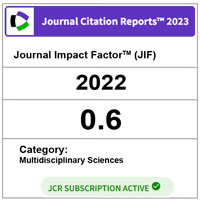Qualitative and quantitative biological studies of three chemotypes of basil essential oils grown in Malaysia against E.coli, S.aureus and P. aeruginosa
DOI:
https://doi.org/10.11113/mjfas.v8n2.131Keywords:
Essential oil| Basil (Ocimum basilicum L.), minimum inhibitory concentration, Esherichia coli, Staphylococcus aureus, Pseudomonas aeruginosa,Abstract
Different accessions of basil introduced to Malaysia as seeds and cultivated at University Malaysia Pahang (UMP) farm and their essential oils extracted by steam distillation. Three chemotypes of these essential oils with estragole, linalool and methyl cinnamate as dominant compounds were evaluated against three facultative anaerobic bacteria obtained from the National Pharmaceutical Control Bureau, Ministry of Health Malaysia: namely, Escherichia coli, Pseudomonas aeruginosa (Gram-negative) and Staphylococcus aureus (Gram-positive) by qualitative and quantitative method. Different concentration ranged from 10 μL/mL to 1000 μL/mL of basil essential oil solutions prepared and tested against bacterial strain using agar well diffusion and quantitative methods. Minimum inhibitory concentration (MIC) was performed using broth microdilution plate. Eight different concentrations of serial two-fold dilutions ranged between 250 μL/mL and 1.95 μL/mL performed using Magellan software of Tecan Infinite Series M200 Pro microplate reader. In the result of agar well diffusion test, the zone of inhibition increased as the concentration of essential oil increased. The MIC was 7.81 μL/mL for all chemotype of the oils against E.coli and S.aureus while 15.63 μL/mL for P.aeruginosa of linalool-rich chemotype and 31.25 μL/mL for estragole and methyl cinnamate-rich chemotypes. The results obtained in this study were considered encouraging the potential of basil essential oil for medicinal uses as antibiotics and hygienic purposes as antibacterial products.References
Alam Sher, Gomal J. Med. Sci.,7(2009), 72-78.
Chang S.T, Chen P.F. and Chang S.C., J. Ethnopharmacol. , 77 (2001), 123-127.
Suzan Ozturk and Sezai Ercisli., J. Ethnopharmacol., 106 (2006), 372-376.
Karaman S., Digrak M., Ravid U. and Ilcim A., J. Ethnopharmacol., 76 (2001), 183-186.
Shafi P.M., Rosamma M.K., Jamil K. and Reddy (2002)., Fitoterapia, 73 (2002), 439-441.
Akram A., Reichling J. and Schnitzler P., Programs and Abstracts/ Antiviral Research, 82 (2009), A1-A83.
Omidbeygi M., Barzegar M., Hamidi Z. and Naghdibadi H., Food Control, 18 (2007), 1518 – 1523.
Erler F., Ulug I. and Yalcinkaya B., Fitoterapia, 77 (2006), 491-494.
Bakkali F., Averbeck S., Averbeck D. and Idaomar M., Food Chem. Toxicol., 46 (2008), 446 – 475.
Simon J.E., Quinn J. and Murray R.G.. Basil: A source of essential oils. In J. Janick and J.E. Simon(Eds)., Portland: Timber Press, 1990, 484- 489.
Nour A.H., Elhussein S.A., Osman N.A. and Abduelrahman H.N., J. Appl. Sci., 9 (2009), 2645-2648.
Dambolena J.S., Zunino M.P., Lόpez A.G., Rubinstein H.R., Zygadlo J.A., Mwangi J.W., Thoithi G.N., Kibwage I.O., Mwalukumbi J.M. and Kariuki S.T., Innov. Food Sci. Emerg. Tech., 11 (2010), 410-414.
Azhari H.N., Salah A.E., Osman N.A., Ahmed N.E., Abduelrahman A.A., Yusoff M.M., J. Appl. Sci., 9 (2009), 4161 – 4167.
Hussain A.I., Anwar F., Sherazi S.T.H. and Przybylski R., Food Chem., 108 (2008), 986 – 995.
Runyoro D., Ngassapa O., Vagionas K., Aligiannis N., Graikou K. and Chinou I., Food Chem., 119 (2010), 311 – 316
Koffi Koba, Poutouli P.W., Raynaud C., Chaumont J.P. and Komla Sanda., Bangladesh J. Pharmacol., 4 (2009), 1 – 8
Carović-Stanko K., Orlić S., Politeo O., Strikić F., Kolak I., Milos M. and Satovic Z., Food Chem., 119 (2010), 196 – 201
Abduelrahman A.H.N., Elhussein S.A., Osman N. Al. and Nour A.H., J. Chem. Tech., 1(2009), 1-10.







